From ancient origins to modern interpretations, discover how the 'House of Prayer' in the Bible shapes spiritual practices today.
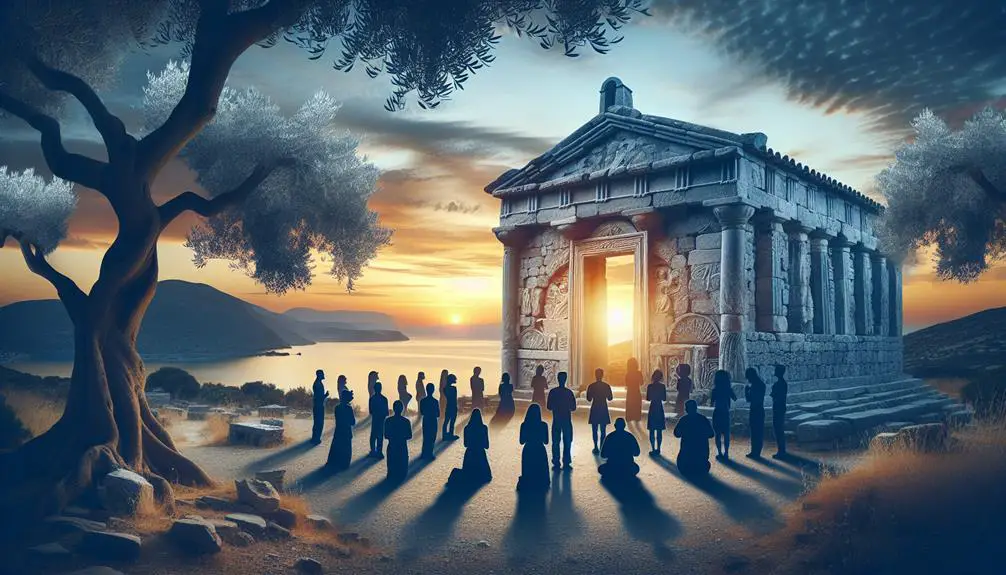
House of Prayer in the Bible
In your next group chat, you might not bring up the 'House of Prayer' from the Bible, but its significance spans centuries, embedding itself deeply in spiritual and communal life. From its origins in the Old Testament to Jesus' dramatic cleansing in the New Testament, this concept evolves, reflecting changing understandings of worship and divine presence.
As you engage with this topic, consider how these historical perspectives on prayer and worship influence modern faith communities. The journey from Solomon's grand dedication to today's interpretations invites a deeper look into how these sacred spaces inform our own practices and beliefs.
Key Takeaways
- The concept of a House of Prayer evolves from a physical tabernacle to a communal center for worship and divine encounters.
- Prophetic visions in the Bible, such as those by Isaiah, Ezekiel, and John, enrich worship with deep symbolism and divine revelation.
- Jesus redefines the concept of the House of Prayer, emphasizing genuine worship over mere ritual and challenging traditional religious authority.
- Modern worship practices, influenced by New Testament teachings, incorporate technology to foster inclusivity, community outreach, and global connectedness in worship.
Origins in the Old Testament
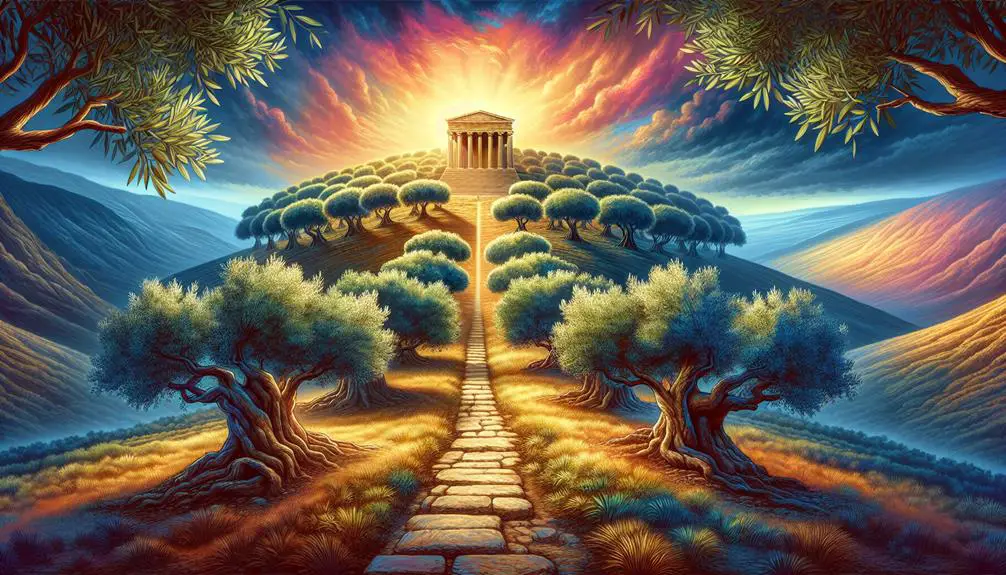
In the Old Testament, the concept of a House of Prayer emerges as a central element of worship and community life among the Israelites. This notion is deeply intertwined with the Tabernacle's origins, serving as the initial physical manifestation of God's presence within the Israelite community. The Tabernacle, a portable sanctuary, was intricately designed under divine instructions to Moses, signifying a nascent stage in the evolution of worship. It wasn't merely a space for ritual sacrifices; it represented a profound transformation in how the Israelites connected with the divine, emphasizing accessibility and communal involvement.
As worship evolved, the Tabernacle's role extended beyond a mere place of offerings to become a pivotal center for communal gatherings and prayer, solidifying its status as the first House of Prayer. This evolution reflects a shift from an itinerant worship practice to a more structured and collective experience. The progression from a mobile Tabernacle to a permanent sanctuary underscores a theological and societal maturation, setting the stage for future developments in religious practice. This foundational period highlights the dynamic nature of worship and the central role of communal spaces in fostering a shared spiritual identity.
Solomon's Temple Dedication
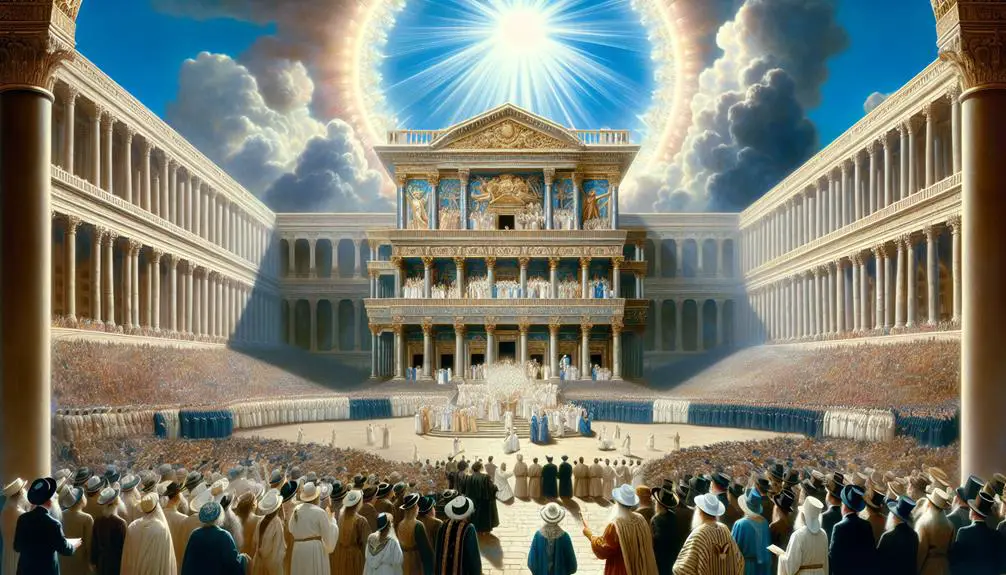
Marking a pivotal moment in the history of worship, Solomon's Temple dedication signified a profound shift towards a centralized, enduring place for communal prayer and divine encounter. This event wasn't just a religious ceremony; it was a monumental celebration of architecture, engineering, and faith converging. Solomon's Temple, with its intricate architectural design, brought forth a new era in the spiritual and physical landscape of the believers.
The dedication of Solomon's Temple is remarkable for several reasons:
- The architectural design was unparalleled, setting a standard for religious structures.
- It overcame significant construction challenges, showcasing advanced engineering for its time.
- The dedication ceremony underscored the temple's role as a divine dwelling place, central to worship.
- It symbolized a unification of the people under a single place of worship, strengthening communal bonds.
Analyzing the dedication, you'll notice how it not only celebrated the completion of a physical structure but also marked the culmination of divine promise and human endeavor. The architectural design and construction challenges underscore the temple's significance beyond a mere building; it was a testament to faith, innovation, and communal identity.
Prophetic Visions of Worship

In examining the prophetic visions of worship within the biblical narrative, you encounter pivotal moments where Isaiah, Ezekiel, and John provide distinct yet interconnected insights into divine worship.
Isaiah's temple vision, Ezekiel's glory encounter, and John's revelation worship each underscore a unique aspect of spiritual veneration, set against the backdrop of their respective historical and theological contexts.
These accounts not only enrich our understanding of worship's evolution but also highlight the enduring significance of the House of Prayer across the ages.
Isaiah's Temple Vision
Isaiah's temple vision, as narrated in the scriptures, serves as a profound prophetic insight into the nature of worship and divine encounter. This vision is rich in visionary symbolism, offering layers of meaning about how humans interact with the divine realm. As you delve into Isaiah's experience, consider the following aspects:
- The role of visionary symbolism in understanding divine messages.
- The significance of divine encounter within a sacred space.
- Isaiah's response to witnessing the holiness of God.
- The transformative power of this vision on Isaiah's prophetic ministry.
Analyzing Isaiah's temple vision reveals the intricate relationship between worship, prophecy, and divine revelation. It's a testament to the profound impact that visionary experiences can have on an individual's spiritual journey and their understanding of God's presence and holiness.
Ezekiel's Glory Encounter
Shifting our focus to Ezekiel's encounter with divine glory, we explore another profound prophetic vision that illuminates the complex dynamics of worship and divine presence. Ezekiel's vision is rich in visionary symbolism, encapsulating divine transcendence. Through his eyes, you grasp the awe-inspiring nature of God's glory, challenging your understanding of worship's essence.
Aspect |
Significance |
|---|---|
Chariot Vision |
Symbolizes divine mobility and presence. |
Four Living Creatures |
Represent the omnipresence and omniscience of God. |
Wheels within Wheels |
Illustrates God's sovereign control over all events. |
Radiant Glory |
Depicts the unapproachable light of God's holiness. |
Voice from the Throne |
Emphasizes authority and the centrality of divine speech. |
This table captures the multifaceted layers of Ezekiel's vision, inviting you into deeper contemplation of divine worship's nature.
John's Revelation Worship
John's Revelation unfolds a visionary landscape of worship, revealing divine mysteries through apocalyptic imagery and profound symbolic acts. This narrative is an intricate tapestry, weaving together elements of prophecy, worship, and divine judgment. As you delve into this prophetic vision, you encounter:
- The outpouring of the *Seven Bowls* of God's wrath, symbolizing the culmination of divine judgment.
- A celestial *Dragon Battle*, representing the cosmic struggle between good and evil.
- Visions of celestial beings engaged in acts of worship, emphasizing the sanctity and sovereignty of God.
- The final victory of God over evil, celebrating the establishment of a new heaven and a new earth.
These elements blend to form a profound message about the nature of divine worship and judgment, urging believers to maintain faithfulness and hope amidst trials.
Jesus and the Temple Cleansing
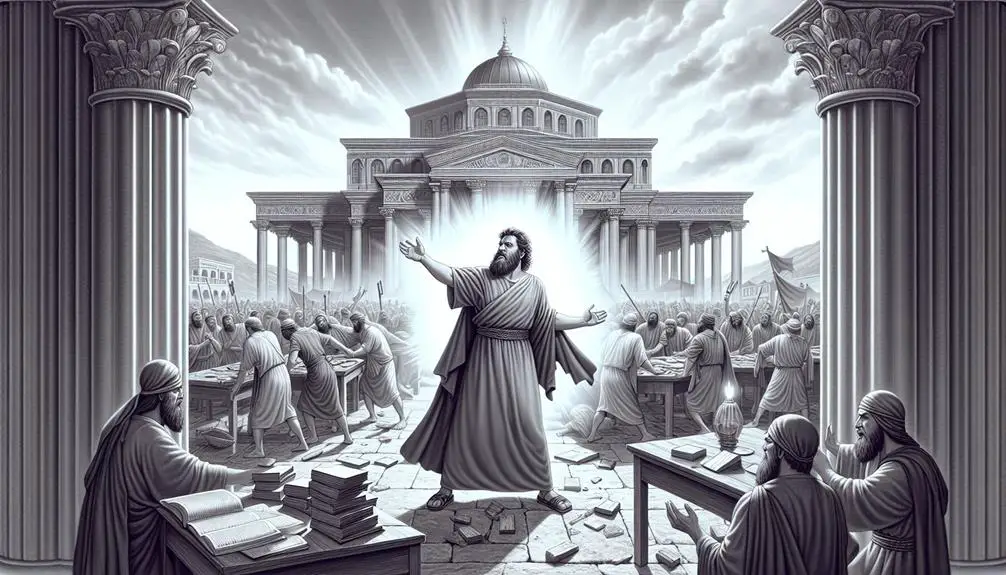
You'll notice that Jesus' act of cleansing the temple is pivotal, not only as a demonstration of divine zeal but also as a moment that sparks intense scrutiny of his authority.
This event underlines the temple's role as a house of prayer, juxtaposed against practices that Jesus deemed corrupt or distracting from worship.
The subsequent questioning of Jesus' authority by religious leaders further illuminates the tension between established religious practices and the transformative message he brought.
Temple Cleansing Significance
One can't overlook the profound significance of Jesus cleansing the Temple, an act that symbolically challenged the existing religious and social practices of His time. This event wasn't just about physical cleansing but carried deeper meanings:
- It questioned the prevailing market dynamics within a sacred space, suggesting a conflict between commercial activities and spiritual worship.
- Highlighted the cultural implications of turning a place of prayer into a marketplace, critiquing how societal values had strayed.
- Exposed the misuse of religious authority, calling for a return to genuine worship and devotion.
- Urged a reevaluation of the relationship between the sacred and the secular, advocating for a space truly dedicated to God.
This act of cleansing was a radical call to reform, urging a shift back to authentic spiritual practices and values.
Jesus' Authority Questioned
Following the temple cleansing, Jesus faced intensified scrutiny as religious leaders questioned His authority to enact such a bold reform. This episode marks a pivotal moment in the New Testament, illustrating the religious challenges Jesus encountered throughout His ministry.
The leadership tests He faced weren't merely questions of tradition or theology but were deeply intertwined with the social and political fabrics of the time. These leaders, threatened by Jesus' growing influence, sought to undermine His teachings and question His legitimacy.
Jesus' response to their challenges, however, further solidified His role as a reformative figure, challenging the status quo and redefining the concept of spiritual authority. This confrontation underscores the tension between divine authority and human institutions, a theme central to understanding the dynamics of power in religious contexts.
New Testament Perspectives
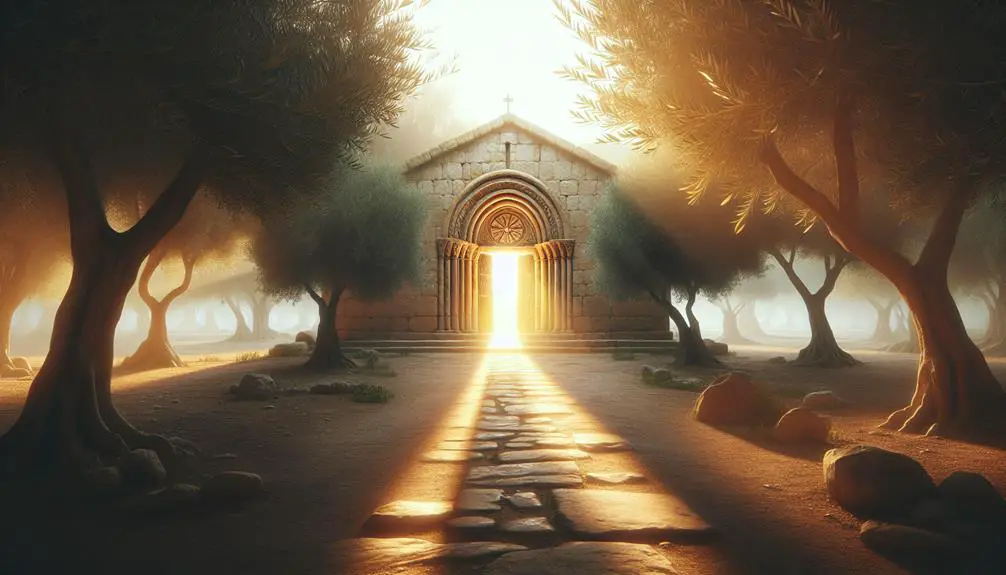
In the New Testament, the concept of the house of prayer evolves significantly, reflecting a shift towards a more inclusive and spiritual understanding of worship spaces. This evolution is markedly influenced by several key developments:
- Paul's teachings emphasize the breaking down of barriers between Jews and Gentiles, laying the groundwork for Gentile inclusion in the Christian faith. He advocates for a universal approach to worship, where the house of prayer is no longer confined to a specific location but extends to wherever believers gather in Jesus' name.
- The early Christian communities, as described in Acts and Paul's letters, meet in homes, suggesting a move away from traditional temple worship to more intimate, inclusive gatherings.
- Jesus' actions and parables, particularly his cleansing of the temple and discussions with the Samaritan woman at the well, signal a redefinition of what constitutes sacred space.
- The writings of the apostles further reinforce the idea that believers themselves are the temple of the Holy Spirit, thereby transforming the concept of the house of prayer from a physical location to the collective body of Christ's followers.
This significant shift underscores a broader theological movement towards inclusivity and spiritual universality in the New Testament.
Modern Reflections and Application
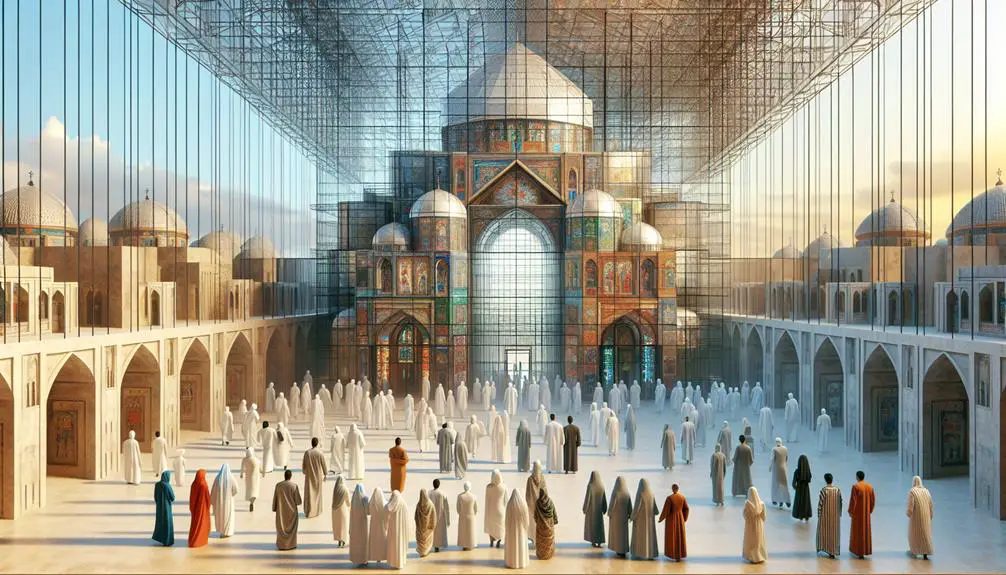
Reflecting on the New Testament's transformation of the house of prayer, we now explore its modern implications, understanding how these foundational changes continue to influence contemporary worship and community dynamics. The evolution from a physical space to a concept that embodies community outreach and digital worship has redefined the very essence of what it means to be a house of prayer in today's world.
Aspect |
Impact on Modern Worship |
|---|---|
Digital Worship |
Allows for broader, more inclusive participation, breaking down geographical barriers and fostering a global community. |
Community Outreach |
Shifts focus from inward-looking practices to outward service, aligning worship with acts of kindness and support for the wider community. |
Social Media |
Utilizes platforms for prayer requests, sharing of sermons, and community engagement, bridging the gap between traditional and contemporary practices. |
Online Giving |
Facilitates easier contributions to church activities and community projects, emphasizing stewardship and generosity in worship. |
Virtual Communities |
Creates spaces for discussion, prayer, and study, enriching the spiritual life of participants beyond physical church walls. |
This table encapsulates the multifaceted ways in which the concept of a house of prayer has adapted to meet the demands of the modern world, grounding itself in tradition while embracing innovation.
Frequently Asked Questions
How Have Different Christian Denominations Interpreted the Concept of the "House of Prayer" Differently Throughout History?
You've noticed how Christian denominations have uniquely interpreted the 'house of prayer' concept, shaping their denominational architecture and prayer practices.
Historically, these interpretations have diverged, reflecting theological beliefs and worship styles. For instance, Catholics emphasize ornate churches, aligning with their sacramental view, whereas Quakers prefer simplicity, focusing on the inward experience.
This diversity illustrates how the understanding of a spiritual space evolves, deeply influenced by doctrinal nuances and communal identity.
Can the Notion of a "House of Prayer" Be Found in Other Religions Outside of Christianity and Judaism, and if So, How Is It Understood or Practiced Differently?
Yes, the concept of a 'house of prayer' extends beyond Christianity and Judaism.
In Islam, mosques symbolize communal unity and personal reflection, serving as pivotal places for prayer and community gatherings.
Hindu temples, adorned with intricate carvings, stand as cosmic crossroads where the divine and earthly meet, facilitating personal devotion and communal worship.
Each, in its own way, interprets and practices this sacred space, reflecting diverse spiritual landscapes.
How Has the Archaeological Study of Ancient Worship Sites Influenced Our Understanding of the Biblical Concept of the "House of Prayer"?
Archaeological studies of ancient worship sites have deeply enriched your understanding of worship practices.
By examining artifact preservation and adhering to excavation ethics, you've gained insights into the physical spaces where communities gathered, prayed, and connected with the divine.
This exploration not only illuminates historical religious behaviors but also challenges and expands current interpretations of sacred spaces, offering a broader, more nuanced perspective on what constitutes a 'house of prayer' across cultures and epochs.
Are There Any Recorded Instances of Significant Religious or Political Leaders Who Have Attempted to Physically Recreate or Embody the Ideals of the "House of Prayer" in Modern Times?
You're asking if modern leaders have tried to recreate or embody 'house of prayer' ideals, focusing on architectural symbolism and political motivations.
Yes, many have. Leaders often use architectural symbolism to embody these ideals, merging spiritual and political motivations.
For instance, national monuments or places of worship are designed to reflect these values, serving both as a homage to spiritual heritage and a statement of political identity or aspiration.
How Do Contemporary Digital and Virtual Worship Spaces Align or Conflict With the Biblical Descriptions and Intentions of a "House of Prayer"?
You're navigating how digital worship spaces align with traditional worship concepts. Imagine a virtual reality church service where attendees from around the globe gather. This scenario raises questions about community and sacredness in digital realms.
While these platforms offer inclusivity and accessibility, they challenge traditional notions of physical sanctity and communal worship, potentially redefining what constitutes a spiritual gathering in the modern era.
Conclusion
So, after traipsing through the annals of history, from the grandiose dedication of Solomon's Temple to Jesus flipping tables in a divine rage, we've seen the evolution of the house of prayer from a physical locale to a spiritual concept.
The New Testament flips the script, suggesting your heart might just be the VIP lounge for the divine.
Modern reflections? They oscillate between profound and profoundly amusing, as we attempt to reconcile ancient sanctity with our Wi-Fi enabled spirituality. Who knew the divine could be so adaptable?



Sign up